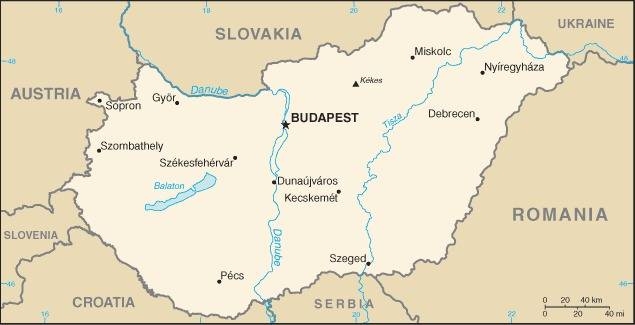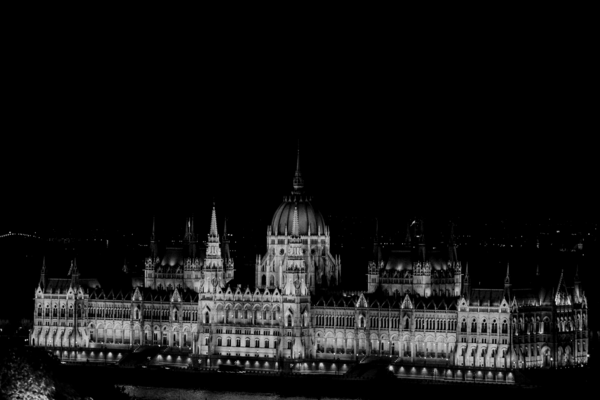82 Hungary

Three equal horizontal bands of red (top), white, and green; the flag dates to the national movement of the 18th and 19th centuries, and fuses the medieval colors of the Hungarian coat of arms with the revolutionary tricolor form of the French flag; folklore attributes virtues to the colors: red for strength, white for faithfulness, and green for hope. Alternatively, the red is seen as being for the blood spilled in defense of the land, white for freedom, and green for the pasturelands that make up so much of the country.
Flag courtesy of the CIA World Factbook

Map courtesy of the CIA World Factbook

The Hungarian Parliament Building is situated on Kossuth Square in the Pest side of the city, on the eastern bank of the Danube. It was designed by Hungarian architect Imre Steindl in neo-Gothic style and completed in 1904. It is still the largest building in Hungary. Standing 96 m (315 ft) high, it is one of the two tallest buildings in Budapest, along with Saint Stephen’s Basilica. The height number of 96 refers to the nation’s millennium, 1896, and the conquest of the Kingdom of Hungary in 896. The main façade overlooks the River Danube, but the official main entrance is from the square on the east side of the building.
Photo courtesy of the CIA World Factbook
Government
According to Britannica, the modern political system in Hungary contained elements of autocracy throughout the 19th and 20th centuries, but in the period between 1867 and 1948 it had a functioning parliament with a multiparty system and a relatively independent judiciary. After the communist takeover in 1948, a Soviet-style political system was introduced, with a leading role for the Communist Party, to which the legislative and executive branches of the government and the legal system were subordinated. In that year, all rival political parties were abolished, and the Hungarian Social Democratic Party was forced to merge with the Communist Party and thus form the Hungarian Workers’ Party. After the Revolution of 1956 it was reorganized as the Hungarian Socialist Workers’ Party, which survived until the fall of communism in 1989.
In 1989 dramatic political reforms accompanied the economic transformation taking place. After giving up its institutionalized leading role, the Hungarian Socialist Workers’ Party abolished itself (with the exception of a small splinter group that continues under its old name) and reshaped itself into the Hungarian Socialist Party. In October 1989 a radical revision of the 1949 constitution, which included some 100 changes, introduced a multiparty parliamentary system of representative democracy, with free elections. The legislative and executive branches of the government were separated, and an independent judicial system was created. The revision established a Constitutional Court, elected by Parliament, which reviews the constitutionality of legislation and may annul laws. It also provides for an ombudsman for the protection of constitutional civil rights and ombudsmens’ groups for the protection of national and ethnic minority rights.
The 1989 constitution was amended repeatedly, and a controversial new constitution, pushed through by Prime Minister Viktor Orbán’s centre-right government, was promulgated in January 2012. Among other significant recent revisions of Hungarian law was a change in 2010 that allowed nonresidents to attain citizenship if they could prove their Hungarian ancestry and mastery of the Hungarian language.
Supreme legislative power is granted to the unicameral National Assembly, which elects the president of the republic, the Council of Ministers, the president of the Supreme Court, and the chief prosecutor. The main organ of state administration is the Council of Ministers, which is headed by the prime minister. The president, who may serve two five-year terms, is commander in chief of the armed forces but otherwise has limited authority. The right of the people to propose referendums is guaranteed.
Hungary is divided administratively into 19 megyék (counties), which are further split into 174 districts (járások). Budapest has a special status as the capital city (főváros), headed by a lord mayor (főpolgármester) and divided into 23 districts (kerületek), each headed by its own mayor (polgármester). There are also 23 cities and towns with county status (megyei jogú városok). Among the extensive changes to the political system introduced by the Fidesz party after its sweeping victory in the 2010 federal elections was a significant reform of Hungary’s local government structure. Changes to the system of finance and to administrative responsibilities enhanced the powers of the central government agencies and institutions at the expense of local and regional governments, whose purview was limited to providing basic services.
As a result of judicial reform that began in 2012, the administration of Hungary’s courts was centralized under the president of the National Judiciary Office (NJO). Elected by parliament, the NJO president has extensive power over the court system, including the recruitment and promotion of judges, as well as control of the system’s purse strings. Because the counterbalancing powers of the National Judiciary Council—the self-governing body of judges elected by other judges, are considerably less than those of the NJO, a number of European organizations, including the European Commission, have stridently questioned the independence and impartiality of the Hungarian judicial system.
At the top of Hungary’s four-tiered ordinary court system is the Kúria, or Supreme Court. Beneath it are the Regional Courts of Appeal, Regional Courts, and District Courts, as well as Administrative and Labour courts. The constitutionality of the laws is overseen by the Constitutional Court, which began operation in 1990.
National Transport Authority
The National Transport Authority is an agency of the government of Hungary. Its head office is in Budapest. The agency, which governs air, road, railway, and water transport, began operations on 1 January 2007. It had replaced the General Inspectorate of Transport, the Central Inspectorate for Transport, the Local Transport Inspectorates in the counties of Hungary, and the Civil Aviation Authority. The Transportation Safety Bureau is the agency that investigates transport accidents and incidents.
Airspace
SkyVector – Google Maps – ADS-B Exchange
ICAO countries publish an Aeronautical Information Publication (AIP). This document is divided into three parts: General (GEN), En Route (ENR) and Aerodromes (AD). ENR 1.4 details the types of airspace classes they chose to adopt from classes A through G.
HungaroControl
HungaroControl, the Hungarian air navigation service provider (ANSP), provides air navigation services in Hungarian airspace and – on a NATO assignment – in the upper airspace over Kosovo, trains air traffic control personnel and conducts air navigation research and development.
Drone Regulations
Register your drone – Registration of UAS operator in the case of a natural person
– The application is from the Unmanned Aircraft System ( UAS ) operator register
– Application in the register of operators of unmanned aerial vehicle systems ( UAS )
– Application for a Light UAS Operator’s Certificate (LUC)
– The application is from the Unmanned Aircraft System ( UAS ) operator register
– Application in the register of operators of unmanned aerial vehicle systems ( UAS )
– Registration of UAS operator in the case of a legal entity
– UAS registration in the case of a legal entity owner
– Request for Unmanned Aircraft System ( UAS ) registered data
– UAS Operating License Application
Mydronespace – Airspace use permit. In order to protect the fundamental right to privacy, operations may only be carried out in occasional airspace over a populated area. You must initiate the designation of emergency airspace at the military aviation authority.
Advanced Air Mobility (AAM) Regulations & Policies
Bilateral agreements facilitate the reciprocal airworthiness certification of civil aeronautical products imported/exported between two signatory countries. A Bilateral Airworthiness Agreement (BAA) or Bilateral Aviation Safety Agreement (BASA) with Implementation Procedures for Airworthiness (IPA) provides for airworthiness technical cooperation between the FAA and its counterpart civil aviation authorities.
Reciprocal acceptance of aviation safety-related approvals and services with the European Union Aviation Safety Agency (EASA) and Member States of the European Union are primarily governed by the U.S. – European Union Safety Agreement.
Advanced Air Mobility (AAM) News
2023 – Rolls-Royce awarded EUR4.6 million from Hungarian Government to advance AAM electric flight
2021 – Budapest residents are quite welcoming towards urban air mobility vehicles
Short Essay Questions
Scenario-Based Question
You have been hired by a Drone Startup Company. Your boss has immediately assigned this job to you.
They need you to prepare a one-page memo detailing the legalities of using a drone to film in Budapest, pictured above.
They need you to mention any national laws and local ordinances.
They specifically want to know what airspace (insert pictures) you will be operating in and whether or not you need an airspace authorization.
Does it matter whether or not you are a citizen of the country?
Lastly, there is a bonus for you if, as you scroll through this chapter, you find any typos or broken links!
Short Essay Questions
- What are the drone categories?
- How is registration addressed?
- How is remote ID addressed?
- What are the model aircraft rules?
- What are the commercial drone rules?
- Are there waivers or exemptions to the rules? If so, for what?
- Would you share a link to an interactive airspace map?
- How is BVLOS addressed?
- How can you fly drones at night?
- How can you fly drones over people?
- Where do you find drone NOTAMs?
- What are the rules for drone maintenance?
- What are the rules for an SMS program?
- What are some unique rules not mentioned above?
- What are the C-UAS rules?
- What are the AAM rules?

